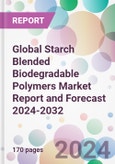According to the report, the global starch blended biodegradable polymers market attained a volume of 542.34 thousand tons in 2023. Aided by the escalating concerns over plastic pollution and a conscientious shift towards sustainable alternatives, the market is poised for a steady rise, the market is projected to further grow at a CAGR of 12% between 2024 and 2032 to reach a volume of 1,535.02 thousand tons by 2032.
Starch blended biodegradable polymers, commonly synthesised by integrating starch and lower amounts of synthetic polymers, have emerged as a crucial player in the global shift towards sustainable plastic alternatives. Recognised for their biodegradable nature, these polymers present a promising solution to the overwhelming environmental challenges posed by conventional plastics, especially in single-use applications.
The global urgency to mitigate plastic pollution is undeniably one of the primary drivers propelling the starch blended biodegradable polymers market growth. As landfills overflow with non-biodegradable plastic waste, impacting both terrestrial and marine ecosystems, the demand for environmentally friendly alternatives is surging. Governments, industries, and consumers are progressively acknowledging the detrimental ecological impacts of synthetic plastics, placing starch blended biodegradable polymers at the forefront of sustainable solutions.
Furthermore, the versatility of these biopolymers accentuates their demand across various sectors. Their applications span from packaging, agriculture, medicine to even electronics. In the packaging industry, for instance, their biodegradable nature makes them apt for producing carry bags, mulch films, and food packaging, reducing the carbon footprint significantly.
Influencing the starch blended biodegradable polymers market outlook is the burgeoning health and wellness movement. As consumers become more health-conscious, there's a growing aversion towards synthetic polymers, especially in food packaging, due to potential toxin leaching. Starch blended biodegradable polymers, being predominantly organic, address this concern, thus gaining consumer preference.
On the industrial frontier, the advantages of these polymers go beyond just their biodegradability. Their properties, such as film-forming and binding, are being harnessed in various sectors. In agriculture, they're used to produce controlled-release fertilisers and pesticides. Simultaneously, in the medical sector, their biocompatibility and non-toxic nature are being utilised for drug delivery systems and surgical sutures.
The rise in governmental regulations and bans on single-use plastics across many countries are bolstering the starch blended biodegradable polymers market demand. As more governments enforce stringent rules on plastic usage, manufacturers are prompted to explore and adopt starch blended biodegradable polymers as an eco-friendly alternative. Incentives, subsidies, and tax benefits offered for the production and adoption of these biopolymers further bolster the market's ascent.
Starch blended biodegradable polymers, commonly synthesised by integrating starch and lower amounts of synthetic polymers, have emerged as a crucial player in the global shift towards sustainable plastic alternatives. Recognised for their biodegradable nature, these polymers present a promising solution to the overwhelming environmental challenges posed by conventional plastics, especially in single-use applications.
The global urgency to mitigate plastic pollution is undeniably one of the primary drivers propelling the starch blended biodegradable polymers market growth. As landfills overflow with non-biodegradable plastic waste, impacting both terrestrial and marine ecosystems, the demand for environmentally friendly alternatives is surging. Governments, industries, and consumers are progressively acknowledging the detrimental ecological impacts of synthetic plastics, placing starch blended biodegradable polymers at the forefront of sustainable solutions.
Furthermore, the versatility of these biopolymers accentuates their demand across various sectors. Their applications span from packaging, agriculture, medicine to even electronics. In the packaging industry, for instance, their biodegradable nature makes them apt for producing carry bags, mulch films, and food packaging, reducing the carbon footprint significantly.
Influencing the starch blended biodegradable polymers market outlook is the burgeoning health and wellness movement. As consumers become more health-conscious, there's a growing aversion towards synthetic polymers, especially in food packaging, due to potential toxin leaching. Starch blended biodegradable polymers, being predominantly organic, address this concern, thus gaining consumer preference.
On the industrial frontier, the advantages of these polymers go beyond just their biodegradability. Their properties, such as film-forming and binding, are being harnessed in various sectors. In agriculture, they're used to produce controlled-release fertilisers and pesticides. Simultaneously, in the medical sector, their biocompatibility and non-toxic nature are being utilised for drug delivery systems and surgical sutures.
The rise in governmental regulations and bans on single-use plastics across many countries are bolstering the starch blended biodegradable polymers market demand. As more governments enforce stringent rules on plastic usage, manufacturers are prompted to explore and adopt starch blended biodegradable polymers as an eco-friendly alternative. Incentives, subsidies, and tax benefits offered for the production and adoption of these biopolymers further bolster the market's ascent.
Market Segmentation
The market can be divided based on polymers type, end use, and region.Market Breakup by Polymers Type
- Biodegradable Starch
- Durable Starch
Market Breakup by End Use
- Flexible Packaging
- Agriculture and Horticulture
- Rigid Packaging
- Consumer Goods
- Others
Market Breakup by Region
- North America
- Europe
- Asia Pacific
- Latin America
- Middle East and Africa
Competitive Landscape
The report looks into the market shares, plant turnarounds, capacities, investments, and mergers and acquisitions, among other major developments, of the leading companies operating in the global starch blended biodegradable polymers market. Some of the major players explored in the report are as follows:- Novamont S.p.A.
- Rodenburg BioPolymers
- Guangzhou Zeesan Biotechnology Co. Ltd.
- BASF SE
- Others
Table of Contents
1 Preface2 Report Coverage - Key Segmentation and Scope4 Key Assumptions7 Industry Opportunities and Challenges11 Value Chain Analysis16 Industry Events and Developments
3 Report Description
5 Executive Summary
6 Snapshot
8 Global Starch Blended Biodegradable Polymers Market Analysis
9 Regional Analysis
10 Market Dynamics
12 Price Analysis
13 Feedstock Market Analysis
14 Manufacturing Process
15 Competitive Landscape
List of Key Figures and Tables
Companies Mentioned
- Novamont S.p.A.
- Rodenburg BioPolymers
- Guangzhou Zeesan Biotechnology Co. Ltd.
- BASF SE
Methodology

LOADING...








